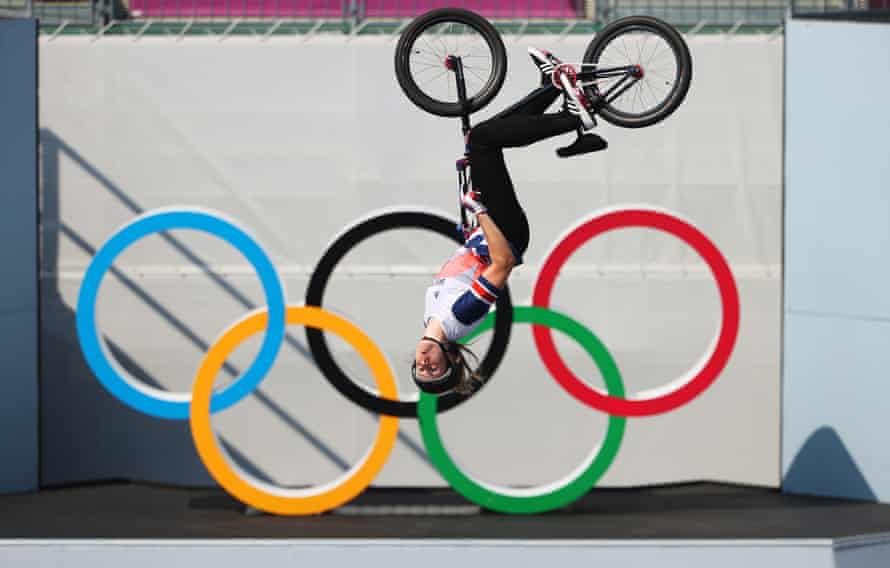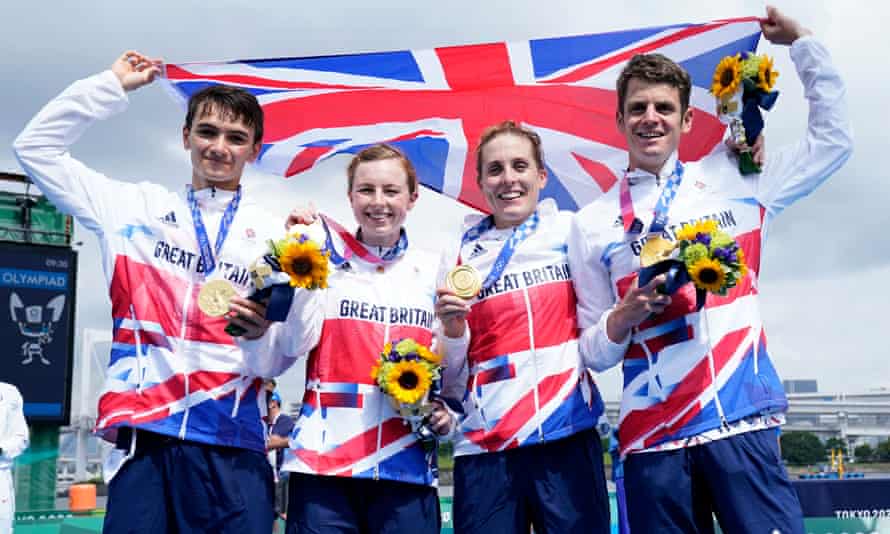
It was one of the most heartwarming images of the Tokyo Olympics. In the aftermath of the women’s BMX final, the newly minted gold medallist Beth Shriever sat slumped on the track in front of a metal barrier, her legs splayed uselessly in front of her. She had pumped every last drop from them to see off the world No 1, Mariana Pajón, in a thrilling chase to the line. Now they couldn’t even lift her to her feet.
Within seconds, her GB teammate Kye Whyte was at her side. Whyte had taken silver in the men’s race that preceded Shriever’s, but you could see in his face what meant more to him. She mumbled something about not being able to feel her limbs. So he scooped her up in her arms and they celebrated the moment together.
BMX is such a male-dominated affair in Britain that UK Sport initially withdrew its funding for female athletes after Rio, believing there wasn’t enough talent to justify a programme. Just two days after Shriever won Britain’s first BMX gold, Charlotte Worthington secured its second in the women’s freestyle title. In her final routine, the 25-year-old became the first woman to land a 360-degree backflip in competition – she had been competing for only four years.
Shriever says she hopes that their joint achievements have “proved our point”. “What Charlotte and I have done has made people realise there’s high potential for women to succeed in this sport,” she says. What’s interesting about the experiences of these two champions is that after their experiences outside the system – crowdfunding to cover travel expenses, working part-time as a teaching assistant and waitress respectively – Shriever and Worthington had spent the past couple of years training full-time with their male peers. The reason Whyte was so excited for Shriever was that he had witnessed first-hand what she had put herself through.
In 2021, sport seemed more open than ever to the notion of women training, performing and competing on the same stage as men. Mixed relay events made their debut at the Olympic Games in the pool and on the track. Cricket launched a new tournament that offered the same profile to its women’s and men’s teams. The trend is a promising one for gender equality, not least because it breaks the mould that has for so long cast women’s sports as an adjunct to men’s.
The advantages of more gender-mixed environments have been many and instantaneous. Worthington says that in other circumstances, that famed 360 might never have been in her arsenal. “Performing tricks is so much about mental capability and confidence,” she says. “If I’d been training with women I might have been held back by what’s been achieved already – or rather, what had never been achieved.” Shriever, meanwhile, watched as the men around her learned a new attitude from the way she worked. “They’ve learned to treat and respect women a bit more. It creates a much more positive environment.”

The staging of the Hundred, English cricket’s new domestic tournament, spread those happy outcomes even further. While plenty of fans had decried the need for more short-form cricket in the game’s already strained calendar, most of them agreed on one thing: it did wonders for the prestige, and the following, of the women’s game. In a counterintuitive piece of scheduling, the Hundred kicked off with a women’s fixture at The Oval which instantly broke both attendance and viewing figures, and records continued to be broken throughout its six-week run. The BBC’s prime-time coverage created a number of new stars among the young fanbase it was targeting – including the then 16-year-old Alice Capsey, who was still waiting for her GCSE results when she scored a half-century on her debut.
“That first game was daunting,” admits Capsey. “There were international players like Tash Farrant and Mady Villiers and Dane van Niekerk all saying that was the best crowd they’d played in front of. I was a bit naive going into it, I’d only played a bit of county cricket – this was a completely new experience, not being able to hear what your teammate was saying 10 metres away!”
Capsey ended up playing every game, including the final against Southern Brave at Lord’s, where she contributed to Oval Invincibles’ victory with both bat and ball. She says there is huge anticipation among her fellow cricketers at the massive interest the Hundred has sparked in the women’s game. “Everyone’s really excited about how we’re going to build on it next year,” says Capsey. She hopes that in its next edition the men’s and women’s teams will be more closely integrated – “some teams like Southern Brave and Birmingham Phoenix were really big on combining the two sides, but Covid regulations made it more difficult.”
For many, one of the most enjoyable features of the Hundred was itself a byproduct of Covid – the fact that most of the games were played as double-headers, ensuring unusually gender-mixed crowds in the stands. The family-friendly atmosphere was a good look for the sport, whose one-day and T20 matches can often evolve into rowdy, binge-laden affairs. Sports fans have long resigned themselves to the idea that antisocial behaviours are just the price you pay for a stadium atmosphere: here was proof that a change in tradition isn’t always a bad thing.

Elsewhere, 2021 saw major sporting breakthroughs in a variety of traditionally masculine arenas. There are certain sports where the only thing that has ever prevented men and women competing on an equal footing has been male opposition to the idea. Darts is one of those – and in the Nordic Darts Masters, Fallon Sherrock finished runner-up to the legendary Michael van Gerwen, before becoming the first woman to reach the quarter-final of the Grand Slam of Darts in November.

While Sherrock’s ceiling-smashing achievements made her the darling of the oche, jump racing was experiencing an even more seismic shock. At the Cheltenham Festival, Rachael Blackmore’s six winners – including the Champion Hurdle – led to her being named the leading jockey, the first woman ever to receive the title. But it was her pitch-perfect race on Minella Times in the Grand National that secured her the national spotlight, and an everlasting legacy.
Only 20 women have ever competed in Aintree’s marquee race; half of their rides have come in the past decade. The speed with which they have proved themselves on equal terms is astonishing. Given the natural weight advantage and tradition of horsemanship that pertains to women, it is just as extraordinary that is has taken so long for horse racing to learn to value them.

For Laura Collett, who won team eventing gold in Tokyo alongside Tom McEwen and Oliver Townend, the injustice is stark. “In equestrianism, gender has never been an issue: we’re all treated as completely equal and see ourselves that way. But in racing, which I’m very into, it’s only recently you’ve got the likes of Rachael or Hollie Doyle being given the opportunity. Rachael sees herself just as a jockey, not a female jockey – that’s what it should be like. It makes me realise how lucky we are in our sport.” Within days of returning home from the Olympics, Collett, McEwen and Townend were back competing against each other in their regular events.
And while mixed relay triathlon was a first for this year’s Olympics, teaming up was nothing new for its inaugural winners. “I’ve been doing mixed relays for a few years now and I’ve always loved it,” says Georgia Taylor-Brown, who took gold alongside Jess Learmonth, Jonny Brownlee and Alex Yee. “I was really aware that if we did well in the very first one at the Olympic Games we’d go down in the history books.”

Their triumph was more than just another notch in GB’s medal tally: it fired the imagination of the watching public. For Taylor-Brown, it was an expression of the strong collegiate spirit that exists between Britain’s male and female triathletes. “We’re quite a small family – we’ll go to a world series race with only 10 or so athletes, so you’re all close and it’s very inclusive,” she says. “I’ll go out with the guys’ group ride, and Jess will swim with them in the pool because she’s probably quicker than a lot of the boys anyway.”
Taylor-Brown thinks we’ll see more and more sports adopting a more mixed-gender approach in future. “Mixed genders adds an even better dynamic to the race because you don’t know what’s going to happen,” she says. “Just look at the swimming mixed relay, when GB were quite far behind after the first leg. All of a sudden Adam Peaty’s chasing down the women’s 100m breaststroke champion – it’s really dramatic, and tactically fascinating.”
